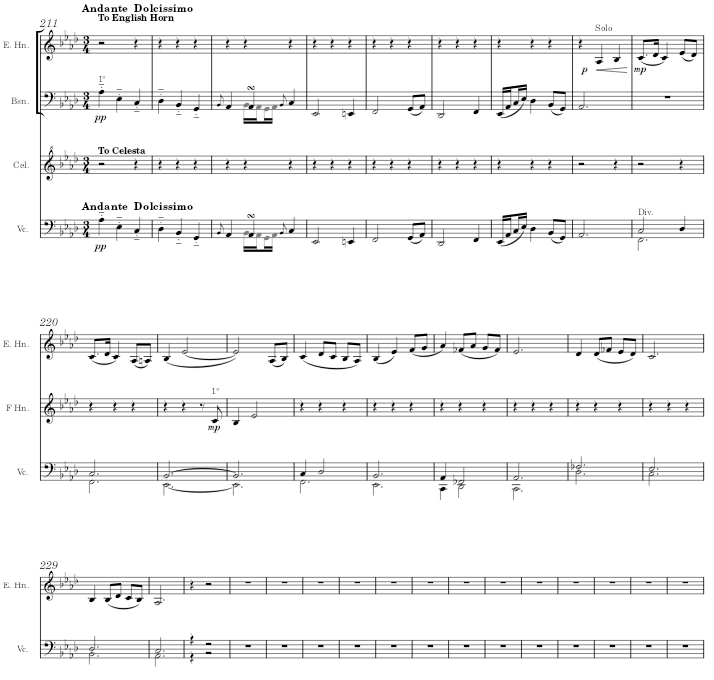
Beethoven is God
Members-
Posts
27 -
Joined
-
Last visited
About Beethoven is God

Profile Information
-
Biography
Well I exist I guess?
Oh and I'm learning composition with a teacher, and by research, reading, etc. -
Gender
Male
-
Location
Israel
-
Occupation
Existance
-
Interests
Well I'm on a forum called "young composers" so... oh and TTRPGs too
-
Favorite Composers
Beethoven is God, Tchaikovsky is almost God, and you've got some other great composers but I won't label them as gods
-
My Compositional Styles
Romantic!!!!!!!!!!!!!!!!!!!!!!!!!!!!!!!!!!!!!!!!!!!!!!!!!!!!!!!!!!!!!!!!!!!!!!!!
-
Notation Software/Sequencers
Musescore
-
Instruments Played
Piano, Saxophone
Recent Profile Visitors
879 profile views
Beethoven is God's Achievements
-
Listening to this and looking at the score I have a few thoughts: 1. The introduction sounds like it has an ending. That's usually not desired. 2. Something just sounds weird there, I can't put my finger of it... I didn't look at the harmony thoroughly, maybe it's that, but maybe it's just about the MIDI. 3. Are you forming out structure before you have all the motives? I wouldn't do that. I'd recommend writing down all themes and ideas ahead - it'll make it easier to just flow with the music from theme to theme instead of "okay so I've done the first theme, Perfect Authentic Cadence and then we're moving on to the second theme" many people do, that causes sectional pieces with weak flows.
- 26 replies
-
- 1
-

-
- help!
- first movement
-
(and 2 more)
Tagged with:
-
Actually I think Scheherezade is monophony. But however, these are all still subtypes of Homophonic and Polyphonic types...
- 8 replies
-
- orchestra
- movement 1
-
(and 1 more)
Tagged with:
-
The Violins I are doubled at the woodwinds, V II, and Va. Oh right thanks. Thanks a lot! Thank you. I'll check your works out indeed. As for my style - it is certainly Beethoven-ish. However I think that if Beethoven himself had the chance, he'd have used the full orchestra too. For the length - I just followed the music. When it ended, it ended. However I did get it wrong when I repeated the intro. I'll have to elongate the development in order to remove that and keep balance, so next version might be longer. I'll look at improving that. It'd require completely rewriting the whole thing, but I'm willing to do so to make it better. However I do feel that polyphonic textures there will feel "pasted"... Maybe I can do that in the development, I'll see about that. That was musesounds... I already started posting drafts. Check the link on the main post. I took my own notes from those better than me. Try classical music and early romantic or russian neo-classical/romantic.
- 8 replies
-
- orchestra
- movement 1
-
(and 1 more)
Tagged with:
-
Technically I'm still in C major until that G# appears. Maybe... I'll see. Indeed it is intentional.
- 8 replies
-
- orchestra
- movement 1
-
(and 1 more)
Tagged with:
-
So, started working on the second movement (the Celesta staff is there because the Glockenspiel changed to Celesta at this movement). This is a Theme and Variations movement, and this is the theme. Changes in instrumentation this movement: Glockenspiel->Celesta, Ob. II changes to English Horn for some parts (as you can see, the movement has an English Horn solo very close to the start), Flute II changes to Alto Flute for some parts.
-
The "Can I point out the melody correctly" YouTube challenge
Beethoven is God replied to chopin's topic in Challenges
Okay here's mine with a drive link. I'm mainly referring to the first theme at the first 20 or so bars. https://drive.google.com/file/d/1ifNHTOexqfHLNbF4M6OzR_7xQQ1psv3m/view?usp=sharing https://drive.google.com/file/d/1uoCKcOVOSr9mluYZoNezoN8vVg1umVLT/view?usp=sharing -
You all speak about eastern music, but you do know there's a desert in Nevada and California right? Well my advice - make use of more feelings of emotion than feelings of style. A desert does not have much visible life due to lack of water and plants - so maybe use low dynamics, in volume, rhythm, and orchestration. For the first its easy - keep most of the piece on actual low dynamics. For rhythmical dynamic - what I do is having no more than three different rhythms at all time, and at least one of them with long rhythmic values - in slow tempo, quarters are enough. In fast tempo, I'd use at least half notes. For orchestration, I usually do woodwinds in pairs, 2 horns, 2 trumpets, some percussion (here I do use eastern percussion more), and strings. I frequently have the strings muted. Also, most of the time, in the winds and brass, only one of each instrument will play. I use both only rarely, and almost never a2 - my most frequent use of both instruments of a pair is when one plays a melody and the other a countermelody (almost never with the same rhythm) or imitation, with quiet strings in long notes (sometimes tremolo), or in the brass when the two do some kind of triumphant call, also then usually they won't do the same rhythm, or they will do imitation. The brass thing usually stands for the sun or sunrise. Also another trick - to indicate night, have the flute play high to give a feeling of cold, and the muted brass play some spooky night melody, again preferably in slow rhythm. The 1st violins should play high while the rest of the winds should play quiet tremolo (the 1st violins might play that quiet tremolo too, but again, high).
- 11 replies
-
- composing
- soundtrack scoring
-
(and 1 more)
Tagged with:
-
(I'm reposting here because I do not consider this a draft, though I will consider changing it after I'll get feedback) This is the first movement to my first symphony. Drafts have been posted here: Symphony in F minor.pdf Symphony in F minor.mp3
- 8 replies
-
- 2
-

-
- orchestra
- movement 1
-
(and 1 more)
Tagged with:
-
Ambitiousness is no flaw, if one has a teacher or mentor to approach for help. When I wrote my first orchestral work, I was definitely not ready. I used a lot of doubling, messed up registers, had no idea how to write to brass (which is still one of my weaknesses), etc. But my teacher helped me understand whatever I did wrong and fix it, then started teaching me orchestration from the basics - chamber ensembles, string orchestra, etc. It really helped me a lot. So, what I'm trying to say, is that taking on a task too difficult will lead to failure that's for sure - until someone helps you finding flaws and the such - but it will also lead to improvement (unless one believes he knows better, in that case - well, in that case calm down and go slow as you said).
-
Beethoven is God started following Saltypenguin
-
Beethoven is God started following Looking for a composition teacher
-
Looking for a composition teacher
Beethoven is God replied to Saltypenguin's topic in Composers' Headquarters
Edit: misread, now I see you wanted a private message. Edit 2: double misread, I'm dumb, you wanted either. Well too late, I sent a message. -
I thought the arpeggios in the codetta were too much in the background, so I tried revising the orchestration, so after a few revisions and a little help from my friends, here is draft 3.1 (it doesn't deserve it's own new number, not a drastic change): Symphony in F minor.mp3 Symphony in F minor.pdf
-
I've read your comments, thank you very much! I will double those runs in the VlnII and Va. As for the second theme - I'm currently considering a repeat of the C major part, but this time the whole string section does what was once the lower part, this time in forte, and instead of a one note pickup, a triplet (G-A-B-C and B-C-D-E, all parts div.). Meanwhile the brass do the sixteenths. And I'll see how I can make the connections smoother and more excited. without making it too rushed.
-
So here's a second draft of the exposition. Replaced the introduction totally, changed the transaction, changed the instrumentation, changed the codetta. Also got rid of the "Triumphalis" part and I'm gonna give in to the dread of it in the development. And last - I used Musesounds this time. Specific question I thought about - does the long note between the second theme and the codetta with the brass arpeggios makes it seem too sectional? What if I took the whole codetta and moved it to one bar earlier so that it continues the second theme immediately?Symphony in F minor.pdf Symphony in F minor.mp3







